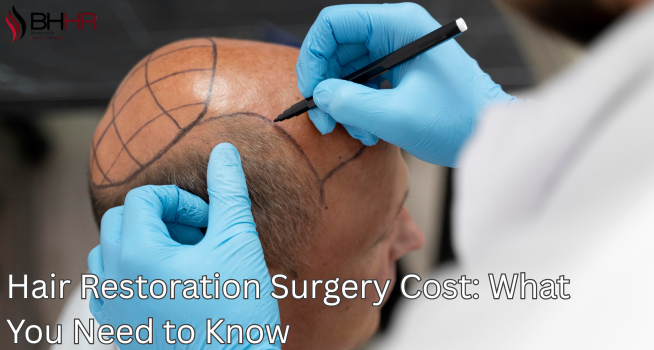
Hair loss is a common struggle that affects millions worldwide, regardless of gender. It often shows up as thinning strands, receding hairlines, or noticeable bald spots. For many people, the impact reaches more in-depth than physical appearance, influencing their confidence and overall self-image. That is why surgical hair restoration has become one of the most sought-after solutions. It provides natural, long-lasting results that other temporary options simply cannot match. However, before undergoing treatment, one of the first questions people ask is about the cost of hair restoration surgery. This article breaks down everything you need to know—from average prices to the factors that influence them—so you can make an informed decision about whether the investment is right for you.
What Is Hair Restoration Surgery?
Hair restoration surgery is a medical procedure designed to address baldness or thinning by transplanting healthy follicles from one part of the body to areas that lack density. The most common donor sites are the back or sides of the scalp, where hair is more resistant to hormonal changes that cause baldness.
There are two primary methods:
Follicular Unit Transplantation (FUT): A strip of skin with hair follicles is extracted from the donor site and then transplanted to thinning areas.
Follicular Unit Extraction (FUE): Individual follicles are harvested and placed into the balding areas, offering a less invasive approach with minimal scarring.
Both methods can deliver natural results, though the choice often depends on a patient’s hair type, level of hair loss, and budget. Some clinics also offer advanced techniques, such as robotic-assisted transplants or Direct Hair Implantation (DHI), which may affect pricing.
Average Cost of Hair Restoration Surgery
In the United States, the average cost ranges from $4,000 to $20,000. This range is significant because each patient’s situation is unique. A person who needs only 1,500 grafts for a small area of recession will pay much less than someone requiring 4,000 grafts to restore a full crown. On a per-graft basis, costs usually fall between $4 and $12 per graft. Since the number of grafts is directly tied to the size of the balding area, this is the single biggest factor influencing total cost. To illustrate:
Factors That Influence the Cost
Several important elements play a role in determining the final cost of hair restoration surgery:
Technique Used – FUE procedures typically cost more than FUT because they are more time-intensive and require advanced tools.
Number of Grafts – The more follicles needed, the higher the cost. A small touch-up procedure may fall near the lower end of the range, while a full restoration will lean toward the higher side.
Surgeon’s Expertise – Surgeons with years of experience and strong reputations often charge premium fees, but their skill reduces risks and ensures better results.
Clinic Location – Prices differ by geography. Large metropolitan areas, especially those known for medical tourism, often have higher fees compared to smaller towns.
Technology and Facilities – Clinics that invest in cutting-edge equipment or provide luxury facilities may include these costs in their pricing.
Aftercare and Support – Comprehensive care packages, including follow-up visits and specialised shampoos or supplements, can also affect the total.
Hidden or Additional Costs to Consider
While the quoted price usually covers the main procedure, patients should also prepare for other potential expenses, such as:
Initial consultations with the surgeon.
Medications for pain management, antibiotics, or anti-inflammatory purposes.
Special hair care products are recommended for recovery.
Follow-up visits to monitor progress.
Possible touch-up sessions if extra density is required later.
Factoring in these costs from the beginning provides a more realistic picture of the total financial commitment.
Is It Worth the Investment?
Many patients ask themselves whether the expense justifies the results. The answer often depends on personal priorities. Unlike wigs, sprays, or hair systems that require constant upkeep, surgery provides a permanent solution. Once the transplanted follicles settle, they continue to grow naturally for life. When calculated over years, the cost may be comparable—or even lower—than ongoing expenses for temporary fixes. More importantly, the psychological benefits are invaluable. A restored hairline or fuller crown can boost confidence, improve professional presence, and enhance social interactions. For these reasons, countless patients feel the investment is worth every dollar.
Tips for Choosing the Right Clinic
Because price varies so widely, it is tempting to seek out the lowest offer. However, cheaper does not always mean better. Here are a few tips to ensure you get value without compromising quality:
Look at before-and-after photos from real patients.
Read independent reviews and testimonials.
Ask about the surgeon’s training and certifications.
Verify that the clinic uses modern, safe technology.
Make sure you feel comfortable with the staff and their approach.
Selecting a skilled and reputable surgeon is the single most important step toward achieving natural, long-lasting results.
Conclusion
The cost of hair restoration surgery typically falls between $4,000 and $20,000, with the exact figure depending on technique, number of grafts, surgeon expertise, and location. While the financial investment may seem high, the long-term results and boost in confidence make it worthwhile for many people. By understanding all the factors involved, considering additional costs, and carefully choosing a qualified clinic, you can make a well-informed decision that restores not just your hair but also your sense of self.
Write a comment ...